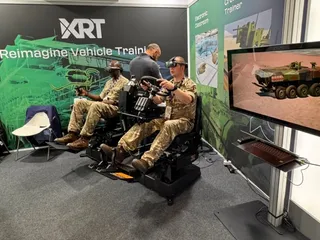Primary Concerns
Contact Our Team
For more information about how Halldale can add value to your marketing and promotional campaigns or to discuss event exhibitor and sponsorship opportunities, contact our team to find out more
The Americas -
holly.foster@halldale.com
Rest of World -
jeremy@halldale.com

Chuck Weirauch takes an in-depth look at some of the current issues facing the regional airline training industry, and how some of these issues will be addressed at the upcoming WATS conference.
Nothing has recently called more media attention to the impact of the shortage of qualified pilots for US regional airlines than the filing for bankruptcy protection by Republic Airways Holdings in late February. According to the Regional Airline Association (RAA), Republic Airways has recently been forced to ground numerous aircraft due to a lack of qualified pilots available to be hired to fly for the airline. This shortage has translated into a loss of revenue which has ultimately resulted in a need to file for bankruptcy protection, the RAA stated.
The bankruptcy filing became big news in USA Today, Forbes Business, the New York Times and other media outlets. That was even though Island Air had shut down its operations the previous December, presumably in part because of the shortage, and many communities have had air services cancelled or disrupted, such as that of Tulsa, OK, Peoria, IL, Elmira, NY and Tyler, Tx, according to the American Association of Airport Executives. While it is disappointing that it has taken such action by Republic to raise national concern about the pilot shortage, perhaps that awareness will lead to more attention to the problem from the US Congress.
Roots of the ShortageWhile the regional pilot shortage problem is one perhaps too well- known by those in the industry, and one that has too often been discussed in industry publications like CAT, it still remains, other than operational safety, the top concern for regional airlines. In fact, it is a major concern for the entire US air transportation industry. Many see its root cause as being the implementation of Public Law 111-216 and the 1,500 hour-to-ATP requirement for First Officers, but the fact remains that, as RAA president Faye Malarkey Black spelled out, “the problem of pilot supply is not limited to Republic Airways, but is endemic throughout the regional airline industry. As unprecedented numbers of major airline pilots reach mandatory retirement age, those airlines are hiring regional airline pilots at a rate that outpaces the supply of new pilots available to regional airline flight decks.”
Less interest by younger generations in an airline career, fewer private pilot licenses being issued in the US, lower entry pay for regional airline pilots – all of these elements have been cited as contributing to the pilot pipeline problem. But even deeper than that, and a bit harder to explain, is the fact that although regionals had, what Black describes as an “ample supply of applications qualified to Federal standards,” in 2015, a considerable number simply were not successfully completing the airlines’ comprehensive requirements to allow them to fly in the right seat of a regional airliner. In many cases, while those applicants may have brought a “wider” degree of experience and education to the table, some of that background is simply not relevant to the role of a regional airline first officer.
The Regionals ResponseHaving predicted a pilot shortage problem as a possible outcome of the implementation of PL 111-216, major airline pilot retirements and the other previously mentioned factors contributing to this situation, US regional airlines have taken several measures to attract new pilots, including higher pay, hiring incentives, and a number of means to help new hires recoup some of their training expenses. To provide insights as to the effectiveness of these programs, representatives from three regionals, ExpressJet, Envoy Air and PSA Airlines, will describe their pilot incentives programs during the 2016 World Aviation Training Conference and Tradeshow (WATS) to be held April 19-21 in Orlando in the Regional Airline Training (RATS) track on Wednesday.
Also at RATS, RAA vice president for Safety & Operations, Stacey Bechdolt, will focus her remarks on the industry’s continued, significant pattern of investment in its pilot workforce; the significant gap between ATPs coming into the system; and the industry’s anticipated need for new pilots. She will also outline the RAA's new solution to the regionals’ pilot shortage problem, its proposed Air Carrier Enhanced (ACE) R-ATP Pathway. According to Bechdolt, the ACE R-ATP represents the collaborative efforts of major and regional airline training experts, and will ensure that incoming industry first officers are prepared with the right experiences, competencies, supports, and oversights to operate proficiently and safely in the demanding commercial cockpit.
In addition to pilot workforce issues, Bechdolt will address the industry’s focus on attracting and retaining skilled aviation technicians and maintenance professionals, and will discuss the industry’s efforts to ensure a modernized air traffic control system reflects and respects regional airlines’ unique role in the system. Along with Bechdolt’s presentation and the incentives for improving the Pilot Pipeline panel, RATS will feature additional speakers covering such topics as an FAA update on the Air Carrier Training ARC, the recently concluded Pilot Source study, the FAA and cockpit automation, and a number of presentations on regional pilot training challenges.
New Hire TrainingLeading off the pilot training challenges session will be Captain Paul Preidecker, Chief Flight Instructor for Air Wisconsin. Paul is also Chair of the RAA’s Training Committee and co-organizer and moderator for the RATS Track agenda. Paul’s presentation is entitled ‘New Hire Pilot Training: Lessons in Change Management’. In this presentation, he will relate how the changes in new hire pilot demographics have led to changes in training footprints. This presentation will present an overview of the changing landscape of training at the regional airlines, with examples of solutions that some airlines have implemented.Prior to the WATS/RATS conference this April, CAT asked Preidecker about what he and his counterparts have recently witnessed as new hire regional pilots tackle the regional airlines training programs, and what are some of the major training issues that have been developing recently with the shift in new hire pilot demographics. By and large, what they have seen is an increase in the training footprint – new pilots needing more time in training than ever before to become qualified to sit in the right seat.Increasing Training Footprint“I have made contact with my counterparts at the other regional airlines, and all seem to be sharing the same challenges and the same stories, not only of pilot demand, but pilot qualification as well,” Preidecker reported. “I think that all of us in the industry who are training managers would probably agree that no matter what side of the line that you are on - whether you think that there is a pilot shortage or not - I think that all of us would say that there has been a change in the amount of time that it takes to get qualified pilots into our system. And I think that there is a variety of reasons for just why the training footprint has increased. One is that it just begins with who we are hiring now.”
New hires coming from two-and four-year college and university training programs, along with flight schools - the traditional pathways - seem to do “pretty well” in airline training programs, since they have been through airline-structured programs, Preidecker said. Because regionals are having to cast a wider net these days to recruit enough new hires from more of a variety of FAA-qualified pilot backgrounds than before, those new pilots are simply requiring more training time (rotary aircraft pilots in particular) because they come from different experiences than the airline environment.
“We are also hiring pilots who are just coming from a variety of experiences - such as doing aerial surveying, pipeline patrol, or flying in the Caribbean Islands,” Preidecker added. “And although they have some good skills, what we are often finding is that they don’t have the current instrument knowledge, or instrument skills, to make the transition into the airline training world. So sometimes we are just having to give some people extra time just so they can get used to operating in the more complex airline environment. We are also hiring more and more foreign pilots, who have the legal right to work and fly in the country, than ever before. They bring additional challenges in equivalent experience of what we need, and sometimes English isn’t their first language, with extra time needed for that education.”
Also increasing new hire training time is the need to provide instruction in how to perform more complex procedures for the increasingly complicated US air traffic control system, as well as other newer requirements, Preidecker explained. The training syllabus of five years ago is no longer adequate because of newer requirements, and more and more training time is needed today just to cover these more complicated procedures, such as RNP and ADS-B, he added.
“And along with the additional simulator time required for such procedures and the newer ATP-CTP requirement , many of these new hire pilots are also requiring more initial operating experience, or IOE,” Preidecker reported. “The FAA minimum for IOE is 25 hours, and we haven’t been seeing people completing their IOE in 25 hours. Most are probably doing so way in the 50- to-55- hour range. And again, it is just a reflection of the type of environment that we are in now in training. We just feel that we want to give the new hires as much experience during their IOE portion of their training as we can. So in addition to our simulator footprint going up, the time for IOE is increasing as well.”
And as if all that was not enough due to the changing new hire pilot demographics, regionals are also finding that they are taking up to 15 simulator sessions to complete their training, whereas in the past new hires would complete their sim time in ten sessions.
“The more time added to the training footprint pressures the system for available simulator time,” Preidecker summed up. “I think that probably every regional operator in the country regards the availability of simulator time as one of their key challenges. We are willing to give people additional time, to make sure that when the time comes for their check ride, they are ready to go. But we are looking for continual progress through training - and even though we are giving people additional time, we are doing so based on the fact that the new hires are demonstrating progress in their training program.”


